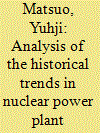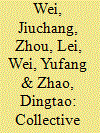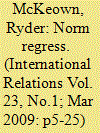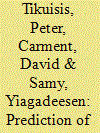|
|
|
Sort Order |
|
|
|
Items / Page
|
|
|
|
|
|
|
| Srl | Item |
| 1 |
ID:
162919


|
|
|
|
|
| Summary/Abstract |
In this study, we collected Japanese nuclear power plant construction cost data from official documents submitted by the electric utilities and conducted a quantitative analysis of the past trends. We found that the unit construction cost of Japanese nuclear power plants rose during the period from 1975 to 1980, when the “improvement and standardization” programs took place, and did not increase or decline significantly after that. We also observed significant economies of scale, even if we take into account interest during construction, as well as the so-called overnight cost. As far as we know, this study is the first attempt to analyze the total history of Japan's nuclear power generation until the Fukushima accident from the cost perspective. The findings could contribute to a better understanding of the economics of nuclear power, as similar studies in the United States and France tend to exhibit different results. The analyses in this study appear to reinforce the reliability of the cost estimation by the Japanese government, which has been used as the numerical basis for the current energy policies in Japan.
|
|
|
|
|
|
|
|
|
|
|
|
|
|
|
|
| 2 |
ID:
131644


|
|
|
|
|
| Publication |
2014.
|
| Summary/Abstract |
Mass incidents are inevitable in contemporary China and the first thing we should learn is to adopt a correct attitude towards them. Based on the three elements-activity, interaction and sentiment-of collective behaviors in 52 mass incidents in China during 2007-2011, we find that collective behaviors in mass incidents show significant differences in activity, interaction and sentiment. A grade evaluation method is proposed to estimate the evolution of collective behaviors in 52 mass incidents and to classify such behaviors into five grades. Then the influence factors on the three elements are analyzed using multiple linear regression. The regression results demonstrate that the impacts of location, casualties, inner-group relations, group scale and duration on the three elements are very significant. Finally, in the light of the regression results, some implications of collective behavior in mass incidents are proposed for the relevant authorities in responding to mass incidents.
|
|
|
|
|
|
|
|
|
|
|
|
|
|
|
|
| 3 |
ID:
087457


|
|
|
|
|
| Publication |
2009.
|
| Summary/Abstract |
Is the norm against torture suffering a crisis of legitimacy within the United States, and if so, does this constitute a crisis in the norm itself? Can constructivist international relations theory explain how the norm came to be significantly weakened by its most important proponent? Constructivist literature on norms has hitherto suffered from a `nice norm bias' that does not adequately take into account the reversibility of so-called `internalized' norms like the one prohibiting torture. Through an examination of the rhetoric, policies and practices surrounding US interrogation after 9/11, this article addresses omissions in constructivist literature by providing a theoretical model to explain `norm regress', or the death of norms. It claims that the torture norm is suffering a crisis of legitimacy within the United States and any future incidences of torture by liberal states may well bring about a crisis of legitimacy in the international norm itself.
|
|
|
|
|
|
|
|
|
|
|
|
|
|
|
|
| 4 |
ID:
119957


|
|
|
|
|
| Publication |
2013.
|
| Summary/Abstract |
The primary objective of this article is to advance the development of early warning of intrastate conflict by combining country-level structural and events data in a logistic regression model calibrated and validated using split-sample cases. Intrastate conflict is defined by the occurrence of one or more highly destabilizing events collectively termed a crisis of interest (COI). Two separate two-year periods between 1990 and 2005 were examined in twenty-five globally dispersed countries. COIs occurred in about 6 percent of all the half-monthly periods examined. While model accuracy (total correct predictions of COI and non-COI) usually exceeded 90 percent, the model did not generate sufficiently high and consistent precision (correct number of COI over total predicted) and recall (correct number of COI over total observed) for practical use.
|
|
|
|
|
|
|
|
|
|
|
|
|
|
|
|
| 5 |
ID:
140656


|
|
|
|
|
| Edition |
1st ed.
|
| Publication |
London, Cassell and Company Ltd, 1969.
|
| Description |
viii, 227p.hbk
|
| Standard Number |
30434917
|
|
|
|
|
|
|
|
|
|
|
|
Copies: C:1/I:0,R:0,Q:0
Circulation
| Accession# | Call# | Current Location | Status | Policy | Location |
| 004086 | 658.4033/CAS 004086 | Main | On Shelf | General | |
|
|
|
|
| 6 |
ID:
154351


|
|
|
|
|
| Summary/Abstract |
Yemen once again descended into chaos in November 2014, when the Houthis seized control of Sana'a. Saudi Arabia and its Gulf Cooperation Council partners, along with mainstream media, characterized the conflict as a sectarian proxy-war with Iran. However, this narrative fails to acknowledge the trajectory of Yemen's Arab Spring revolt. This article refutes this narrative by using theories of revolution to connect the Arab Spring revolt to the current conflict. Situating Yemen within a broader revolutionary moment sheds light on patterns of revolution in Third World societies and the likely outcome of the current conflict.
|
|
|
|
|
|
|
|
|
|
|
|
|
|
|
|
|
|
|
|
|